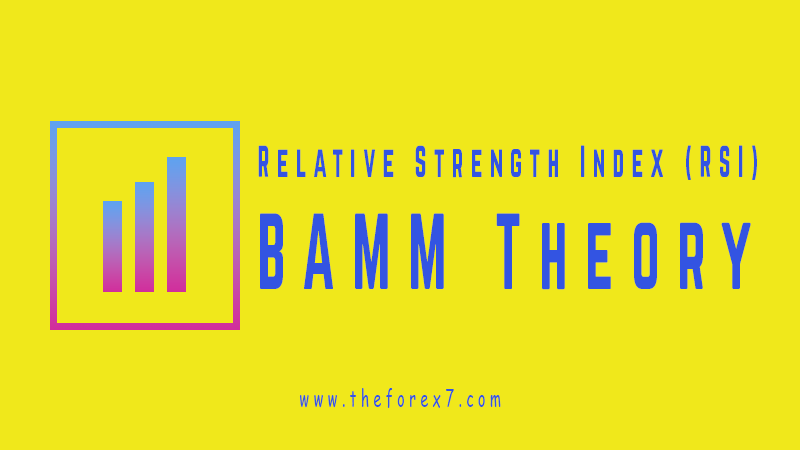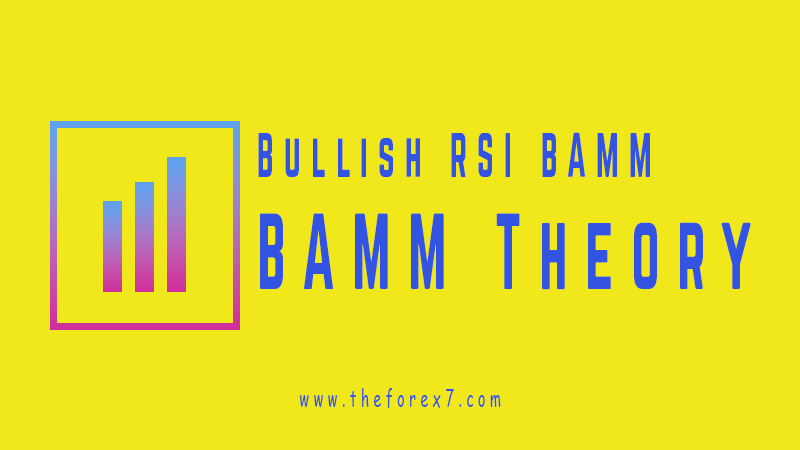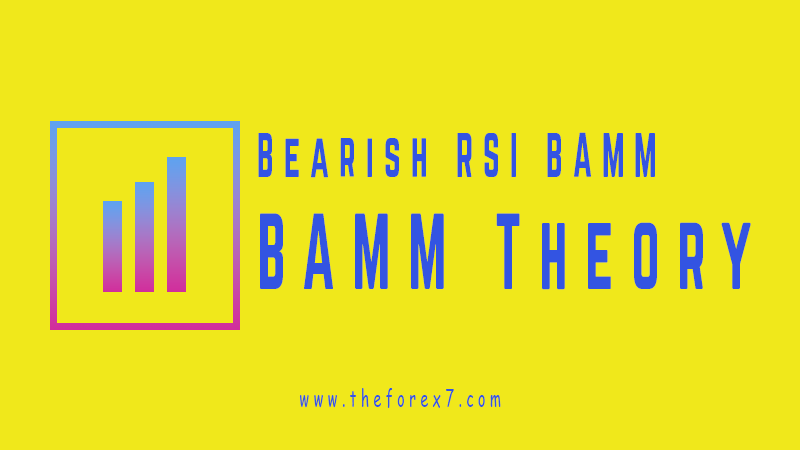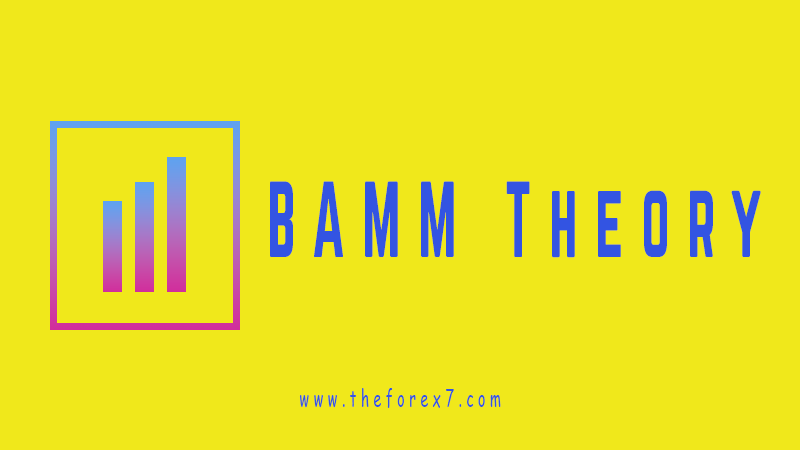BAMM Theory: Bearish RSI BAMM
Steps of Bearish RSI BAMM, Define Bearish Butterfly, Define Bearish BAT, Bearish BAT at RSI BAMM, Bearish trigger bar signals
Course: [ HARMONIC TRADING : Chapter 6: RSI : Relative Strength Index (RSI): BAMM Theory ]
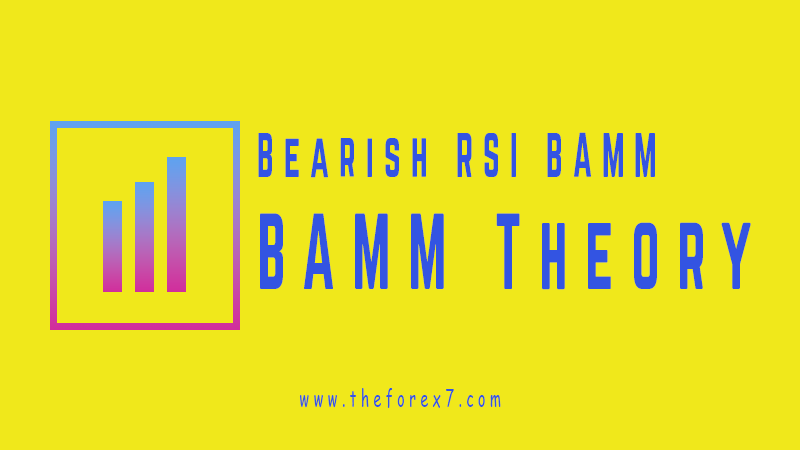
The Bearish RSI BAMM begins with a complex reading above 70. Referring to the RSI BAMM the entire process requires several elements to validate this specific scenario.
BEARISH RSI BAMM
The
Bearish RSI BAMM begins with a complex reading above 70. Referring to the RSI
BAMM illustration in Figure 6.47,
the entire process requires several elements to validate this specific
scenario. Although the entire illustration might seem a bit overwhelming upon
first examination, this represents the ideal RSI BAMM model. I recommend that
you thoroughly study this material before employing these strategies in your
live trading. Each step will be broken down to illustrate the ideal RSI BAMM
model. Obviously, the ideal situation does not occur every time. It is
important to remember that the real application of the RSI BAMM principles will
require a degree of flexibility.

FIGURE 6.47
The
ideal model does present all of the critical elements that clearly explain the
effectiveness of this strategy. But, it will take a period of study to fully
comprehend all aspects of the RSI BAMM approach. In much the same manner that
the initial rules of harmonic pattern identification and differentiation may
have seemed overwhelming, the RSI BAMM rules—albeit a bit complex upon first
study—provide a coherent and comprehensive method for accurately measuring
potential areas of divergence. Furthermore, it is essential to maintain the
patience to execute only those trades that possess all required elements that
validate a trade signal based upon the rules of the RSI BAMM setup. Again, it
is important to remember that this illustration represents an ideal model and a
framework to provide a set of guidelines that attempt to quantify precise
technical events and to optimize overall trading decisions. However, the RSI
BAMM strategy in combination with harmonic patterns effectively validates PRZs
and improves the overall accuracy of the entire Harmonic Trading approach. The
following example of the British Pound (versus the U.S. Dollar) clearly
demonstrates these concepts.
BRITISH POUND/USD (GBP_A0-FX): WEEKLY
BEARISH RSI BAMM
The
weekly chart of the British Pound in Figure
6.48 exemplifies the ideal RSI BAMM approach. It is important to study this
chart as a model to distinguish and to validate RSI BAMM setups. This situation
required more than a year to develop, but it possessed all of the necessary
elements to establish the ultimate reversal at the RSI BAMM Confirmation Point
on the weekly chart.

FIGURE 6.48
STEP 1: INITIAL RSI TEST OF EXTREME BEARISH LIMIT
In
the Bearish RSI BAMM scenario, the first step is to identify price action that
possesses an RSI reading in the extreme zone above 70. As I mentioned
previously, the 70 level for the overbought limit, as well as the 30 level to
define the oversold area, were first outlined by Welles Wilder in his book New
Concepts and Trading Systems. In addition, a 14-period average is calculated
from his approach.
STEP 2: COMPLETE A BEARISH M-TYPE COMPLEX RSI STRUCTURE
The
initial focus should be on the formation of the indicator readings in the
entire extreme overbought range rather than looking for a specific numeric
level. As I outlined earlier in this chapter for the bullish scenario, it is
important to differentiate the two types of indicator structures that form at
RSI extremes.
TWO TYPES OF BEARISH INDICATOR STRUCTURES
In
much the same vein as harmonic patterns, it is important to classify the
general types of indicator structures that form in an overbought RSI area.
Although each type could be assigned more specific classifications, indicator
readings form either an impulsive or a complex structure. It has been my
experience that most bearish RSI readings that are above 70 will be impulsive in
nature and do not yield the required structure to be considered a valid setup.
However, valid complex structures that are correctly identified offer a
tremendous technical advantage because this situation is especially unique and
represents a vital potential reversal area within the overall trend of the
price action.
Sometimes,
a complex RSI BAMM formation can be frustrating because the setup may not
ideally unfold following the initial trigger. This can be particularly
frustrating when a potential setup is followed for quite some time and fails to
adhere to the RSI BAMM model. In the same manner that not all patterns form
ideally, it is important to wait for only those situations that clearly provide
all the required elements to validate the setup. Regardless, the primary focus
of the initial step is to identify a complex the RSI BAMM M-type structure in
the extreme area.
BEARISH IMPULSIVE INDICATOR STRUCTURES
A
bearish impulsive indicator structure reflects price action that is
experiencing a quick test of the extreme overbought resistance area, usually
reversing quickly without any consolidating price action (see Figure 6.49). Since the price action commonly reverses sharply
in these cases, the RSI rolls over and sinks below the 70 level typically
within one or two price bars of the first overbought reading.

FIGURE 6.49
Although
such impulsive formations may test the extreme bearish RSI level, it is
important to focus on the nature of the indicator structure and not necessarily
the exact numeric reading (as long as it is above the 70 limit). The exact
indicator level is critical in quantifying the extreme state of RSI, but the
general indicator formation is the critical factor, as it serves as the essential
trigger to validate a potential trade opportunity.
Impulsive
structures can be effective technical measures as they can serve to confirm
bearish patterns and other trading signals. But it is important to note that
the signals generated from extreme RSI readings do not constitute a
comprehensive approach to trading the market. As mentioned previously, I
believe that this is a common misconception for Relative Strength and most
other technical indicators and oscillators. In my opinion, such technical
measures must be utilized as a complementary methodology rather than as an
exclusive approach. A Relative Strength reading above 70 does not automatically
signify a trade opportunity. In fact, certain extreme impulse structures can
signal significant continuations of the predominant trend. These strategies
will be covered later in the book. For now, it is important to keep in mind the
general types of structures. Furthermore, as is the case with all technical
indicators, other methods must be employed to validate any potential trade
opportunity on a multiple confirmation basis.
BRITISH POUND/USD (GBP_A0-FX): WEEKLY
BEARISH IMPULSE INDICATOR STRUCTURE
Figure 6.50
shows the impulsive RSI in the British Pound that reversed sharply after
exceeding the 70 level.

FIGURE 6.50
It
is important to note how the price action stalled after testing the extreme
overbought area. In this case, the price action reversed decidedly after the
impulsive RSI test was completed.
BEARISH COMPLEX INDICATOR STRUCTURE
A
complex structure represents an indicator formation that initially exceeds the
70 level and forms an M-type structure entirely in the extreme area (see Figure 6.51). The complex
structure remains above the extreme 70 limit longer than an impulsive
formation, and it should be distinct from other types of indicator readings.

FIGURE 6.51
Despite
representing a more significant technical condition than an impulsive
formation, the bearish complex structure is typically an early trading signal.
In fact, it is common for price action to accelerate to the upside while the
complex formation of the RSI reading completes. Furthermore, the initial
reaction to the complex RSI structure may not seem to indicate a change in
trend due to such strong price action. Despite this perceived strength, the
validity of the entire RSI BAMM technique is not determined until the M-type
structures has entirely formed in the overbought area above 70. Although the
advanced concepts will be clearly presented later in this chapter, it is
important to keep in mind that a complex indicator reading is merely the
starting point for the entire approach not the defining event of the RSI BAMM
methodology.
BRITISH POUND/USD (GBP_A0-FX): WEEKLY
BEARISH COMPLEX INDICATOR STRUCTURE
The
example of a complex RSI structure in the British Pound shown in Figure 6.52 possessed all of the
necessary elements to establish the RSI BAMM. As this chart example
demonstrates, the initial test of the complex indicator formation typically
experiences an acceleration of the predominant trend. Despite the perceived
strength of the rally, the complex formation establishes the beginning of the
most critical aspect of the entire RSI BAMM methodology—the divergence phase.

FIGURE 6.52
The
bearish divergence occurs when the RSI reading weakens while the price action
continues to rally. Although the price action may seem to be maintaining its
current uptrend, valid complex RSI structures usually trigger a reversal sooner
rather later and mark a critical area for a potential change in the overall
direction. Although a few other elements must fall into place for the RSI BAMM
to be validated, the complex RSI structure is the starting point for the entire
process. Most important, this is an early signal, and it is critical to wait
for the M-type structure to break under the 70 line. After the RSI formation
has been completed, the other considerations of potential pattern completions
and specific RSI BAMM harmonic measurements can be projected to determine the
optimal reversal area. This leads us to our next step, which includes the
defining and measuring of the price level that triggers this breakdown.
STEP 3: DEFINE THE RSI TRIGGER BAR
After
defining the complex RSI formation, the next step requires a measurement of the
price area where the M-type indicator structure has completed. The price bar
that causes the complex RSI indicator reading to complete the M-type structure
and to decline below the extreme 70 limit is known as the RSI BAMM Trigger Bar (see Figure 6.53).

FIGURE 6.53
After
identifying the RSI BAMM Trigger Bar, it is critical to mark the top of this
price bar by drawing an extended line from the peak, projecting the resistance
to the right of the chart, as illustrated in Figure 6.53. This RSI BAMM Trigger
Bar resistance level serves as a minimum technical area for the corresponding
retest and the anticipated execution area of the completion of the final phase
of the RSI BAMM. From a general perspective, the RSI BAMM Trigger Bar denotes
the starting point for the critical divergence phase that the entire
methodology is attempting to define and to quantify. Again, the completion of
the complex RSI structure is only a starting point of the process. Although
there are strategies that I will present later in this chapter to capitalize on
the initial indicator breakdown, from a broader perspective the RSI Trigger Bar
can reveal a great deal about the validity of the setup and the state of the
potential price action. For now, the most critical element of the RSI BAMM
approach begins after the indicator has reversed from the overbought reading by
completing the complex M-type structure.
BRITISH POUND/USD (GBP_A0-FX): WEEKLY
BEARISH RSI BAMM TRIGGER BAR
The
position of the Bearish RSI BAMM Trigger Bar in relation to the prior extreme
high point is critical. Although its significance will be further explained
later in this section, it is important to remember that the RSI BAMM Trigger
Bar typically will be the price bar that is the prior peak of the current move
or within a few intervals of the extreme high. This is critical, as the Trigger
Bar’s position will determine the execution area for the corresponding retest
and completion of the RSI BAMM.
The
RSI BAMM Trigger Bar in the British Pound example in Figure 6.54 is clearly marked. After drawing a horizontal line to
the right from the top of the Trigger Bar, the complex RSI structure defined
the 1.8750 area as the first critical resistance level for the ultimate retest
at the Confirmation Point.

FIGURE 6.54
STEP 4: REACTION OF RSI AND PRICE
After
the Trigger Bar has been established, the initial reaction from the completion
of the complex RSI structure and the price must be monitored closely. After
topping out in the extreme overbought area above 70, the price action typically
experiences a quick and decisive pullback. This is typically evidenced by a
steady short-term downtrend (see Figure
6.55).

FIGURE 6.55
The
critical divergence phase begins after this brief correction, which is normally
marked by a breakout of the short-term downtrend line. This breakout is
critical in defining the beginning of the divergence phase of the entire RSI
BAMM methodology. Although I will review the other elements in more detail,
this breakout typically will retest the RSI BAMM Trigger Bar area and rally to
either a 1.13 or 1.618 extension while testing the extreme RSI overbought area
above 70.
BRITISH POUND/USD (GBP_A0-FX): WEEKLY
REACTION OF RSI AND PRICE
After
breaking out of the short-term downtrend line, the British Pound started to
rally for the final divergence phase. The final rally included an impulsive
retest of the 70 limit (see Figure 6.56).

FIGURE 6.56
As
the RSI and the price react during this divergence phase, a few technical
aspects must unfold to validate the final test and ultimate execution of the
entire setup.
SPECIFIC TYPE OF RETEST
One
of the most critical aspects of this divergence phase occurs during the initial
reaction following the complex RSI structure completion. After the Trigger Bar
has been established, the RSI reading MUST decline to at least the 50 level
before completing the final divergence— where the price rallies while the RSI
fails to exceed the readings established by the prior complex indicator
formation. Although there is room for interpretation as the RSI reading may
exceed the 50 level on this initial reaction, it serves as a minimum
requirement that precedes the corresponding retest of the resistance area
established by the RSI BAMM (see Figure 6.57).

FIGURE 6.57
Again,
this specific type of retest offers other short-term trading opportunities that
I will explain a bit later in this chapter. But, the important aspect of this
element of the process is a minimum retest to the mid-point (50) level of the
RSI. At this point in the RSI BAMM methodology, the price action typically
declines fractionally while the indicator experiences a sharp correction. So,
it is essential to focus on the indicator reading. After the mid-point 50 limit
is tested, the final divergence phase of the entire approach will begin.
BRITISH POUND/USD (GBP_A0-FX): WEEKLY SPECIFIC TYPE OF RETEST: RSI MID-POINT (50 LIMIT) REQUIREMENT
Following
the initial reaction after the complex RSI formation, the British Pound
declined sharply in price and, more importantly, in the RSI reading (see Figure 6.58). Although the setup
consolidated at the 50 line for several months, the eventual breakout from the
initial downtrend line and the rally in the RSI marked the beginning of the
final phase to complete the RSI BAMM Confirmation Point.

FIGURE 6.58
STEP 5: THE FINAL PHASE—DIVERGENCE OF RSI VERSUS PRICE
Figure 6.59
clearly shows the concept of this final divergence. As the RSI and the price
retest their prior respective resistance points, they diverge in direction. As
the RSI reading reverses after testing the 70 limit, the price action “spills over” the prior high in an attempt to continue the
predominant trend. The “spillover” rally
usually experiences a brief move above the prior high to either a 1.13 or 1.618
extension of the initial breakdown (X-A).

FIGURE 6.59
Later
in this chapter, I will outline the rules that distinguish which harmonic
projection works with the final divergence phase. But, the beauty of this
technical phenomenon is that the breakout is inherently flawed due to the RSI
failure, as the “internal strength” no longer supports the predominant trend.
It is in situations like these where the general technical divergence between
the RSI and the price offers tremendous trading opportunities.
BRITISH POUND/USD (GBP_A0-FX): WEEKLY
FINAL DIVERGENCE PHASE OF RSI VERSUS PRICE
The
British Pound clearly exemplifies the ideal divergent technical situation.
After completing the complex RSI structure, the price action rallied to a
nominal new high (see Figure 6.60).

FIGURE 6.60
The
secondary test of the RSI failed to exceed the prior reading. Moreover, the
impulsive nature of the test further underscored the weakness, as the internal
strength of the last rally barely penetrated the overbought limit above 70. The
price bar that triggers the completion of the impulsive indicator retest is
called the Bearish RSI BAMM Confirmation Bar.
BEARISH RSI BAMM CONFIRMATION BAR
The
critical divergence between the price and the RSI can be seen in Figure 6.61. The RSI BAMM Confirmation
Bar usually completes at either a 1.13 or a 1.618 extension of the prior
decline and defines the divergence point for the entire setup. As the trend of
the price action continues up (notice uptrend arrow), the RSI reading fails to
continue higher, completing an impulsive structure that defines the RSI BAMM
Confirmation Bar.

FIGURE 6.61
If
the RSI Confirmation Bar is a valid resistance signal indicating a reversal at
hand, typically the price action will decline quickly after exceeding the
initial prior high level. Although I will outline the advantages of utilizing
Harmonic Trading techniques of pattern recognition and Fibonacci measurement
strategies with the RSI BAMM, it is important to examine this technical
phenomenon on its own before trying to understand the advanced concepts. Most
important, the simple divergence as marked by the Bearish RSI BAMM Confirmation
Bar provides an effective technical situation that can be further refined with
other trading strategies to define profitable opportunities.
BRITISH POUND/USD (GBP_A0-FX): WEEKLY
BEARISH RSI BAMM CONFIRMATION BAR
The
illustration of the British Pound in Figure
6.62 clearly shows the divergence of the RSI versus the price.

FIGURE 6.62
The
price action at the RSI BAMM Confirmation Point reveals a great deal about the
strength of the predominant trend and defines the trading opportunity at hand.
In essence, the divergent price action at the Confirmation Point rallies in a “last gasp” from the indicator reading. However, the extent of
this “last gasp” must be determined, and specific harmonic measurement
techniques provide the tools necessary to further refine these technical levels
to define excellent trading opportunities.
REVIEW OF RSI AND PRICE
Before
examining the final divergence stage, let’s review the steps for the RSI BAMM
up to this point. The entire process started with a complex RSI structure.
Following this completion, the divergence phase begins, as the RSI reading
pulls back to at least the 50 level. After mid-level RSI check back, the price
action breaks out of the short-term downtrend line of the initial reaction to
initiate the final divergence phase (see
Figure 6.63).

FIGURE 6.63
It
is important to note that the entire RSI BAMM concept is encompassed within
this retest of the resistance, as established by the top of the RSI BAMM
Trigger Bar. Remember, this is a situation where the Relative Strength is
providing an early signal to the end of the predominant trend. Although this
signal may be the end of the trend technically, the price action usually
experiences one last rally to retest the resistance area established by the
complex RSI structure. When the price continues to rally as the RSI fails to
exceed its prior resistance established by the complex reading, the final
divergence phase has begun and the Confirmation Point is near completion.
BRITISH POUND/USD (GBP_A0-FX): WEEKLY
REACTION OF RSI AND PRICE
The
British Pound example possesses all of the ideal elements and price action that
encompasses the RSI BAMM methodology. Figure
6.64 illustrates all of the stages of the RSI divergence. However, the last
phase of this approach employs advanced harmonic measurement techniques and
other trading strategies to determine the validity of the setup and to quantify
the price level for the entry of the trade.

FIGURE 6.64
Essentially,
the various technical measurements are employed to determine an advanced PRZ, where
both RSI BAMM projections and harmonic patterns complete. Although this may
seem a bit complex upon first study, the overwhelming advantage of the
combination of harmonic patterns at the completion of the RSI BAMM pinpoints
critical technical levels and defines incredibly accurate trading
opportunities.
STEP 6: BEARISH RSI BAMM CONFIRMATION POINT: 1.13 VERSUS 1.618
In
the development of the RSI BAMM, I was challenged for quite some time to
discern the correct extension to employ for the Confirmation Point. Although
the difference between 1.13 and 1.618 may appear small, in real trading
situations this gap frequently can be expensive. With respect to the primary
tenets of Harmonic Trading and pattern identification, exact specification of
these areas is critical in pinpointing the precise completion of the setup and
in determining the validity of the overall trading opportunity. Although these
are general rules, I noticed a difference in the RSI BAMM extension within the
final divergence phase. These rules outline two areas—depending upon the
position of the Trigger Bar relative to the prior high—to examine for a
completion of the setup. If the RSI BAMM Trigger Bar is a few price bars
(typically 2–4) from the prior high, the execution of the trade will occur at
the corresponding 1.13 extension. However, an RSI BAMM Trigger Bar that
develops at the extreme high for the move will result in a 1.618 extension at
the Confirmation Point.
1.13 EXTENSION AT RSI BAMM CONFIRMATION POINT
Although
the general rule regarding the Confirmation Point extension differentiates the
1.13 and 1.618 ratios, the focus of the Trigger Bar should be on the extreme
prior peak. Essentially, if the RSI BAMM Trigger Bar is not the high price bar,
the 1.13 extension is utilized to quantify the execution area for the trade (see Figure 6.65).

FIGURE 6.65
BRITISH POUND/USD (GBP_A0-FX): WEEKLY
1.13 EXTENSION AT RSI BAMM CONFIRMATION POINT
Referring
to the British Pound example, Figure
6.66 shows an enlarged image of the RSI BAMM Trigger Bar. Again, the
Trigger Bar is the price bar that results in the RSI reading falling under the
extreme overbought 70 limit. In the case of the British Pound, the RSI BAMM
Trigger Bar occurred three bars from the prior high. Therefore, the corresponding
retest should possess a Confirmation Point that completes at or around the 1.13
extension of the prior initial reaction.

FIGURE 6.66
If
the RSI BAMM Trigger Bar is the extreme high, the 1.618 extension would be
projected to define the area where the Confirmation Point completes. I will
show the 1.618 variation later in the chapter.
STEP 7: PATTERN COMPLETION AT THE RSI BAMM CONFIRMATION POINT
After
establishing the necessary steps to define the final divergence phase of the
RSI BAMM, the addition of harmonic pattern recognition techniques effectively
complements the target execution area for the completion of the Confirmation
Point. This integration immensely improves the accuracy of the Harmonic Trading
techniques to quantify critical technical levels and to define profitable
trading opportunities, as well.
From
a general perspective, the integration of harmonic patterns at the Confirmation
Point represents the most significant advancement of the entire Harmonic
Trading methodology to date. Although I have discussed the importance of other
technical strategies that complement the Harmonic Trading approach in prior
books and articles, the application of advanced trading strategies such as the
RSI BAMM takes this approach to a new level.
The
additional specification of pattern identification within uniquely prescribed
technical situations yields multiple confirmation signals. Such refinement
improves the determination of pattern completions by placing stronger emphasis
on the PRZ, as two separate measurement strategies yield the same result. When
a variety of technical measurement tools yield the same result, the technical
information being provided is typically more reliable and accurate.
In
terms of the RSI BAMM, the Confirmation Point represents only one primary
technical measurement. Albeit as a result of a rather complex sequence of
technical events, the RSI BAMM Confirmation Bar defines more of a general price
area than an exact range. However, the formation of distinct harmonic patterns
within this price area represents powerful trade signals. In particular, a
harmonic pattern at the RSI BAMM Completion Point frequently defines the
precise execution area for a trade. In this manner, the extension at the RSI
BAMM Confirmation Point serves as a minimum entry level before triggering a
trade.
The
importance of these two measurements will be analyzed in the following
examples. Ideally, all of these technical events should complete
simultaneously. Although some situations may not possess all of the ideal
aspects of an RSI BAMM Confirmation Point and harmonic pattern completion, the
integration of these techniques will effectively filter the best trades from
the losers with tremendous accuracy. The following illustrations show the
entire RSI BAMM methodology with various harmonic patterns at the Confirmation
Point.
HARMONIC TRADING : Chapter 6: RSI : Relative Strength Index (RSI): BAMM Theory : Tag: Harmonic Trading, Stock Market : Steps of Bearish RSI BAMM, Define Bearish Butterfly, Define Bearish BAT, Bearish BAT at RSI BAMM, Bearish trigger bar signals - BAMM Theory: Bearish RSI BAMM

